|
Years Of Growth
The gun trade became well established in the 18th
century, employing about 600 people in the manufacture
of gun locks and barrels. These were mainly supplied to
the gun manufacturers in Birmingham, and brought great
prosperity to the town. During the Napoleonic and
Burmese wars guns were in great demand. The trade was
very much a family craft, the skills being handed down
from father to son. Gunlock makers usually supplemented
their income by doing other types of work, because the
gun trade suffered from periods of depression. A typical
worker was John Stokes who was also licensee of the Old
Castle Inn in Pinfold Street, later known as The Old
Castle Hotel. There were a number of families in King
Street that were involved in this trade, including the
Golchers, the Williams, and the Josephs.
|
|
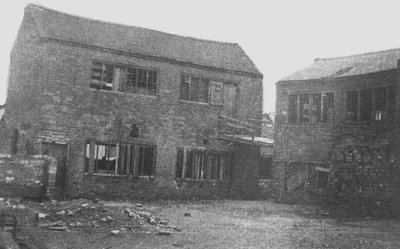
A typical Darlaston gunlock
workshop. |
In the late 1750s there were 300 to 320
gunlock filers, 50 to 60 gunlock forgers, and 250 boys
employed as filers, gunlock forgers, cock stampers, and
pin forgers.
A 14 hour working day was usual with the
truck method of payment often being used. This involved
payment in kind with food or fuel. During the Napoleonic
wars the Birmingham gun trade supplied over 3 million
gun barrels, and 2.8 million gunlocks to the British
Government. The largest recorded production in a single
year was 490,838 gun barrels, and 457,616 gunlocks, in
1813. |
|
After the end of the Napoleonic wars in
1815 the demand fell and Darlaston went into a severe
depression, which lasted until 1839. The remaining trade
was mainly confined to the export market and sporting
guns. The development of machine made locks virtually
eliminated the trade in Darlaston by about 1870. In
Birmingham a smaller trade for hand made sporting guns
continued until the early 1920s, but the manufacturers
tended to make all of the parts themselves, so it was of
no benefit to Darlaston. The last known workshop in the
town was a two storey building that was just to the left
of the present public library in King Street. It was at
the rear of Appleyard's shop and demolished in the early
1970s when the library was built.
Parson & Bradshaw's Directory of 1818
lists the following products that were manufactured in
Darlaston:
| bridle bits,
buckles, bullet moulds, carpenter's tools,
dog collars, files, fire irons, guns,
gunlocks, handcuffs, harness buckles, hasp
locks, nails, padlocks, trunk locks. |
The 1801 census includes the following
information about the population of the town:
|
Population: |
3812 consisting of
1996 males, and 1816 females. |
|
Housing: |
703 inhabited
houses, occupied by 777 families. 59
uninhabited houses. |
|
Employment: |
1325 people
employed in trade, manufacturing, and
handicrafts.
2452 people in other employment. 35 people
working in agriculture. |
| |
|
| View a
commercial and trade directory from 1818 |
 |
| |
|
Darlaston's depression resulted in a
great increase in the number of poor people in the town,
who were helped by payments from local taxes, which were
raised from the middle and upper classes. Many tax
payers believed that they were paying for the poor to be
lazy and so they often complained to the powers that be.
In 1834 a new Poor Law was introduced to reduce the cost
of looking after the poor. Under the terms of the new
law, parishes were grouped into unions, each of which
had to provide a workhouse where the poor could go to
get help. Once in the workhouse they would be made to
wear a uniform, obey the strict rules and regulations,
and work hard.
It is interesting to compare the amount
of poor relief paid in the local towns as a way of
comparing their individual fortunes at the time:
| |
Population
in 1831 |
Total relief 1834-35 |
Total relief per
head of population |
Total relief
1835-36 |
Total relief per
head of population |
|
Darlaston |
6,600 |
£1,251 |
3s.9d. |
£1,453 |
4s.5d. |
|
Wednesbury |
8,000 |
£1,892 |
4s.8d. |
£1,733 |
4s.3d. |
|
Walsall |
14,000 |
£4,409 |
6s.3d. |
£3,714 |
5s.4d. |
|
Willenhall |
5,000 |
£1,075 |
4s.4d. |
£1,028 |
4s.1d. |
|
Bilston |
14,000 |
£3,843 |
5s.6d. |
£2,816 |
4s.0d. |
|
Tipton |
14,000 |
£3,090 |
4s.5d. |
£2,868 |
4s.0d. |
West
Bromwich |
15,000 |
£3,128 |
4s.2d. |
£2,397 |
3s.2d. |
In 1835-36 a lower percentage of people
were receiving poor relief in West Bromwich than in the
other towns, but only Darlaston saw an increase in
payments.
The middle of the last century was at
last a time of growth for Darlaston. After the
opening of the railway, Darlaston's manufacturers went
from strength to strength, greatly increasing the town's
prosperity. A commercial directory of 1851 lists 35 nut
and bolt manufacturers in the town, the large number
being solely attributable to the presence of the
railway.
A report produced by the Children's
Employment Commission in 1843 gives an insight into
what life was like for children and young people in
Darlaston during the early 1840s. The following extracts
are descriptions provided by Charles Thornhill, Charles
Green, and Isaac Clarkson in 1841:
|
|
The
Condition of Children and Young Persons in
Darlaston in 1841
Charles Thornhill, Esq.,
aged 34, Surgeon to the Darlaston and
Bentley district of the Walsall Union:
Has practised ten years in Darlaston; has
had continual opportunities of observing the
treatment and condition of children and
young persons of the working classes, both
in mines and manufactories; can bear
testimony to the fair treatment they
uniformly received from their employers;
they are well fed, well clothed, and for the
most part healthy; is not aware of disease
peculiar to them; they are as healthy as the
children of the adjoining places; would
especially refer to the good treatment of
the apprentices of the miners in this place;
the apprentices of the butties generally
present a very fine physical appearance.
Of their mental and moral
condition, not much good can as yet be said,
but 'there is an attempt at education among
them, and even a great interest displayed in
it by the butties. The number of schools
here is considerable, and the attendance
very large; but the masters and teachers are
not efficient; they have never been trained
in any way beyond that of the schools they
attend, in which, they themselves were
educated. Has noticed the bad ventilation of
some school rooms; would except the national
school of the established church, and a
school room which is spacious and of good
height, such as that of the British school.
Hernia exists here among the
boys, but not to any great extent; considers
it far more prevalent in some of the
adjoining parishes, Willenhall in
particular; attributes its existence in
these parts of the country to over-exertion,
such as lifting heavy weights and drawing
loaded skips of coal, lime, and ironstone.
Thinks among the women there is not much
malformation of the pelvis; labours are
generally easy, but at the same time there
are more than the average number of
preternatural presentations, and instruments
are frequently employed; there are a number
of cases in which haemorrhage occurs;
attributes these circumstances to the fact
of the women winding almost the whole day at
windlasses on pit banks, in screw
manufactories, etc., and to their carrying
heavy weights on their heads, particularly
of coal, which the colliers families are
allowed to have gratuitously, as much as
each carry at a single load a day; each one,
therefore, carries away the utmost possible
to her.
Bronchocele and calculous
diseases prevail here; attributes them to
the water of the neighbourhood, which is
strongly impregnated with the salts of lime
and ironstone. Asthma is also common to
those who have long worked in the pits,
arising from the minute particles of dust
floating in the atmosphere of the pit; and
from the miners catching cold upon cold.
Water abounds in some pits to a great
extent, and the miners work all day in the
wet; this frequently causes a number of
boils to arise in different parts of the
body which come in contact with the water.
Fever is not more prevalent
here than in other parts of the country; but
when it does break out, the cases are of a
virulent kind, and of long duration. These
cases originate in most filthy parts of the
parish, where there is no underground
drainage, where accumulations of filth
abound on the surface. The women here of the
working classes are very prolific, many of
them having a child every year. It is a
common thing here for a woman to have from
nine to twelve children. The number of
illegitimate children is great, many of the
girls having had from three to four each;
there is scarcely any prostitution in the
place, though the inhabitants are numerous.
The young men and women of the working
classes are so constantly associated
together in work-shops, manufactories, and
on the pit banks, at nearly all towns, as to
supersede all prostitution; the improvidence
and want of management among the working
classes is very great; they are as
extravagant as possible whenever they get
the means; many of them will have large
joints of meat on Sundays and the earlier
part of the week, and be in almost a
starving condition by Friday and Saturday;
there is much drunkenness here in the early
part of the week when trade is good; the
women are great smokers.
Charles Thornhill
Mr. Charles Green, aged 62, Malster and
Farmer:
Has lived in Darlaston 28 years. Apprentices
formerly were badly treated by some masters,
ill clothed, and ill fed; and beaten
unmercifully, but in rare cases; they were
in those cases parish apprentices obtained
from other parishes, such as Lichfield,
Stratford, Coventry; at that time there was
some premium given with each apprentice, £4
or £5, and always a suit of clothes.
When the master had got
the boys or girls with the premium, they
cared nothing about them, and would have
been glad if they had been burnt or drowned
to have got rid of them. Thinks it is very
little the case now; thinks the children are
now well fed and well clothed, and not
improperly punished, almost generally;
thinks money is not given now with
apprentices, except from charities left for
that express purpose, which has thus become
abused.
There is a great lack
of education here, or of the wish for it on
the part of parents and masters; there is
much more desire than there was, but far
from a general desire; the Sunday schools
are largely attended, particularly among the
Methodists; believes the teachers are very
incompetent for such an office.
Charles Green
The Rev. Isaac
Clarkson, Vicar of Wednesbury:
Stated, that in his capacity as magistrate,
complaints often came before him, made by
boys against; masters from different places
round about, such as Willenhall and
Darlaston, but he did not encourage them, as
they should more properly apply to the
magistrate of Wolverhampton.
More complaints came
before him from the mines than from the
manufactories; but sometimes there was very
bad usage in the latter. A boy from
Darlaston has recently been beaten most
unmercifully with a red hot piece of iron.
The boy was burnt, fairly burnt. Wished to
cancel the indentures, but the master had
been to the Board of Guardians, or to the
Clerk of the Stafford Union, and promised to
behave better in future. Has various similar
cases brought before him.
A great number of the
small masters are not fit to have
apprentices. Says this with reference to
Darlaston and Willenhall; nothing of that
kind occurs in Wednesbury, except sometimes
in the mines. The number of complaints are
very few from Darlaston; they are mostly
from Willenhall.
Isaac Clarkson |
|
| |
|
View an early
Darlaston map |
 |
| |
|
| The gunlock makers were skilled and resourceful
people. Many of them turned their hands to other
industries, using their metal working skills. By the
1830s the town had a number of small factories producing
a wide range of products including buckles, buckle
tongues, coach harnesses, files, fire irons, hinges,
latches, locks, screws, and stirrups. There were also
iron founders, and stampers. The Carter family, who
lived in Great Croft Street were ex-gunlock makers who
had seven workshops behind their house. They invested in
up-to-date plant and machinery, which included a steam
engine to drive their machines and presses, presumably
by overhead line shafting and belts. There were several
employees, including five apprentices.
 |
The location of Great
Croft Street, which became part of St. Lawrence
Way. |
The business is listed in several trade directories:
The Staffordshire General & Commercial Directory
for 1818
Carter, William stirrup, snaffle,
and girth buckle maker, Great Croft Street
Carter, James stirrup and bridle bit maker, Great Croft
Street
Carter, William roller buckle manufacturer, Croft
Street
Pigot & Company's National
Commercial Directory of 1828
Bit and Stirrup Makers
James Carter, (and pattern ring). Great Croft Street.
Bolt and Latch Makers
James Carter, (screw). Great Croft Street.
Boot & Shoe Heel and Tip Makers
John Carter. Great Croft Street.
Patten Ring Makers
William Carter and Son. Great Croft Street.
Stampers
James Carter. Great Croft Street.
William Carter and Son. Great Croft Street.
William White's 1831 Gazetteer
and Directory of Staffordshire
William Carter & Son, Great Croft
Street, bolt and Norfolk latch makers, stampers
(gunlocks), boot and shoe heel tip manufacturer.
James Carter, Great Croft Street,
bolt and thumb latch maker, stirrup maker, boot and shoe
heel tip manufacturer.
Pigot & Company's Directory of
Staffordshire, 1842 (The business was actually sold
in December 1841)
Bolt and Latch Makers
Carter, James. Great Croft Street.
Carter, William & Son. Great Croft Street.
Boot & Shoe Heel and Tip Makers
Carter, William & Son. Great Croft Street.
Unfortunately a terrible accident
took place on Monday 22nd January, 1838, when the boiler,
which fed the steam engine exploded.
Boiler Explosion
The boiler explosion at Carter's
works was reported as follows: |
|
Staffordshire Examiner 27th January, 1838
Explosion. On Monday
morning, about half past ten o'c1ock, the steam
engine boiler, in the extensive shoe heel tip
and spoon manufactory of Messrs. Carter and Son
in Great Croft Street, Darlaston, exploded with
a tremendous noise, which alarmed the whole
town, and was heard distinctly at a distance of
a mile and a half. The inhabitants in the
neighbourhood were astounded, and many who had
no faith in the millennium pronounced the world
to be at an end. The top of the boiler, ten feet
diameter and seven feet high, weighing a ton and
a half, was torn from its situation and forced
upwards at least fifty yards, descending upon an
angle at a house in Cock Street, one hundred
yards from the factory, breaking a small portion
of the roof, and from thence, rebounding into
the street, rolling against a house opposite,
shattering the doors and window shutters, and
forcing the brick jamb a little out of the
perpendicular.
Had the boiler in the first
instance fallen one yard further, the house must
have been destroyed; or if when in the street it
had rolled another half foot, the second house
would have been stove-in, and must have fallen.
Several pieces of cast iron pipe were found in
Mr. Rooker’s garden and yard in King Street, 150
yards from the scene of accident, one of which
knocked down a fence wall, and so shook the part
of the house adjoining as to admit the light
through the joints of the brickwork.
Bricks were plentifully
scattered over all the yards and streets within
a hundred yards, and yet, most miraculously, not
a single individual was in the least injured
(except a boy who was oiling a part of the
machinery, and who was thrown by the concussion
of the wind against the cylinder, and slightly
bruised on the back of his head) although the
accident occurred in the centre and in the most
thickly populated part of the parish.
A clump of more than fifty
bricks passed directly over the head of a man in
the service of Mr. Thomas Bailey, who was
putting a horse into a cart, and fell five or
six yards beyond him: neither man nor horse were
hurt, although both were terribly frightened.
Several shops belonging to the Messrs. Carter
were partially destroyed, but the damage done is
not so extensive as was at first supposed. It
may appear incredible that the boiler was forced
so high into the air, but several persons who
witnessed its ascent affirm that it was
considerably higher than the steeple of the
church, which is 140 feet. |
|
|
Courtesy of
Peter Carter, James Carter's great, great, great,
grandson. |
|
Sheffield Iris. Tuesday 30th January, 1838.
Explosion of a steam boiler at Darlaston
On Monday last, the
boiler attached to the manufactory of Mr.
Carter, at Darlaston exploded with great
violence. The boiler itself, weighing
upwards of two tons, was carried over the
adjoining houses, and fell in Cock Street, a
distance of 150 yards, doing considerable
damage to two houses in its descent.
It first fell upon a
house on the north side of the street,
occupied by a shoemaker, demolishing a
portion of the roof and the gable end; and
rebounding from thence, fell against a house
on the opposite side of the street, knocking
in the door and a portion of the wall. About
a yard of the steam piping was carried forty
yards further, and propelled against the
house of Mr. Rooker; and falling from
thence, broke down an adjoining wall.
Another part of the piping was blown through
the front window of the same house. The
bricks etc. were scattered in all directions
for one hundred yards, and so great was the
conclusion that most of the houses in the
place were somewhat shaken. Three of Mr.
Carter’s shops were entirely blown down
The accident is mainly
attributable to the intense frost of the
previous night having frozen down the safety
valve. We are happy to say that not a single
individual sustained the least personal
injury, though the escape of several was
almost miraculous. |
|
|
Courtesy of
Peter Carter, James Carter's great, great, great,
grandson. |
| It is amazing that no one was killed, and that
little damage was done. The business, and family
houses in Great Croft Street were sold at auction in
the White Lion pub on Friday 3rd December 1841.
James Carter moved to Blakemores Lane, where he died
in 1843. The family went on to open a large factory
on King's Hill, and later at James Bridge.
An expanding Town
As the population increased in the middle of the
19th century there was a demand for more houses and
so areas around Blockall, The Green, and Catherine's
Cross were developed, usually where little land
reclamation was required. One of the new streets
built off Catherine's Cross, on the northern side of
the Russian Colliery in the 1850s was Foundry
Street, named after nearby Phoenix Foundry, in
Catherine's Cross. |
|
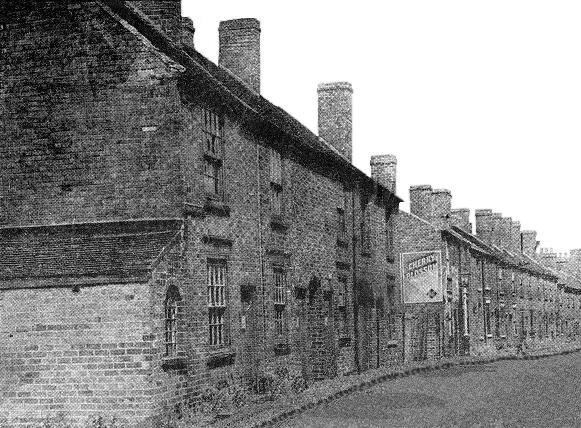
The western end of
Foundry Street. |
Foundry Street, which was demolished in
1955 has completely disappeared. It was
replaced by the three storey blocks of
council flats in Park Street. Phoenix
Foundry was founded in 1830 by John
Garrington to produce forged components for
the gun trade. |
| In 1879 the firm moved to Albert Works
in Willenhall Road. In 1851 part the factory
was occupied by Thomas Wood, as can be seen
from the advert below. |
|
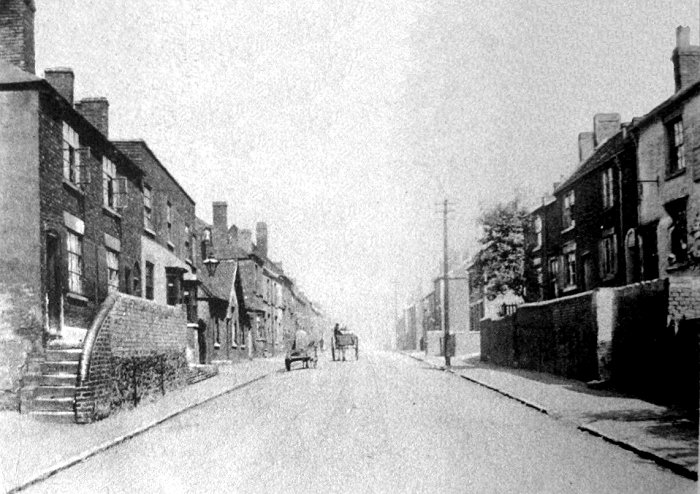
King's Hill. From
an old postcard. |
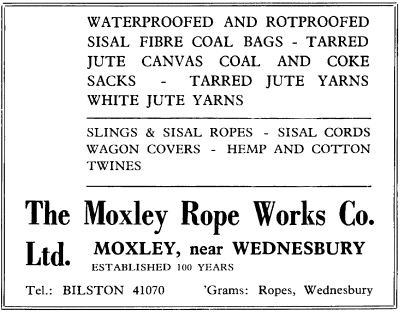 |
The Moxley Rope Works Company Ltd. was formed in
1849, to manufacture ropes for the coal mines. The ropes were made from locally grown flax, but
were rendered obsolete by the invention of the
rattlechain, and later wire rope. As the mining industry
declined, the company started making rope slings, plough
reins, and boat lines. When steam engines became
plentiful, plaited gaskin (packing) was developed.
Gaskin remained in production for the joining of salt
glazed drain pipes, but the main products were lorry
sheets, made from jute canvas and cotton flax, lorry
ropes, and slings for lifting tackle. |
One of the few natural resources that hadn't been
exploited were the deep clay beds that lie along the
Darlaston - Moxley boundary. The clay was first used
commercially by the Moxley Brickworks, which was owned
by the Wood family, who were large landowners in the
Moxley area. Luckily the canal runs through the middle
of the clay beds, so offering easy transportation for
the finished bricks. The works were situated on what was
called The Moxley Sand Beds, off Moxley Road. A short
spur was built from the canal, which ran directly into
the works to facilitate the loading of canal barges.
Moxley Road was previously called Woods Bank, which was
named after the Wood family.
The report by the Children's Employment Commission of
1864 includes a description of the girls who worked at Woods Darlaston
Brickyard:
|
In this yard the
girls had to carry the clay up a steep
rise of about 12 yards in 50 yards.
Mr. J. Swindley,
currier, Freeth Street, Oldbury:
I have lived in the
town 30 years. I am well acquainted with
the habits and condition of the girls
employed in the brickyards. The
employment of young females at this work
is looked upon as a shame by all us
tradesmen. The girls have to do men's
work along with the men. I have often
been shocked to hear the language and
indecent talk among these girls when at
work.
After their work is
over, which is generally about six
o'clock, they dress themselves in better
clothes and accompany the young men to
the beer shops. They are a good deal in
habit of spending their earnings in beer
shops with the men. They are ignorant of
all household work, and quite
uneducated. |
|
The ever expanding population led to more churches, and
a new cemetery. In 1837 the Primitive Methodist Chapel
was built in Bell Street. It replaced a meeting house in
Blakemores Lane, that had been used by the Darlaston
Primitive Methodists since 1814. The building could seat
1,200 people, and was enlarged in 1879. It fell into
disuse in 1908 after the building became unsafe due to
subterranean coal fires, which caused the walls to
crack. The congregation moved to the new chapel in
Slater Street, which opened in 1910. |
| The building was sold in 1910 to a London company,
to be used for the Darlaston Skating Rink. This never
materialised, but in 1912 the same company opened the
Olympia Cinema here instead. The entrance to the cheap
seats was in Bell Street, and the entrance to the more
expensive seats was in Blockhall. The building still
suffered from underground fires, with copious amounts of
sand being thrown down to minimise the effects.
Eventually the cinema's floor had to be replaced with
concrete, but due to the fires, the building was far too
warm in the summer. |
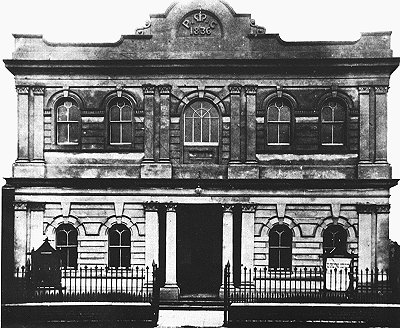
Bell Street Primitive Methodist
Chapel in about 1886. |
| It closed in 1956 and was demolished a few years
later. Also associated with the Primitive Methodist
Chapel was the Primitive Methodist Sunday School in
Willenhall Street. This closed around the same time
as the chapel, and became Darlaston's one and only
theatre, the Queen's Hall, popularly known as the
Blood Tub because each play usually included at
least one murder. |
|
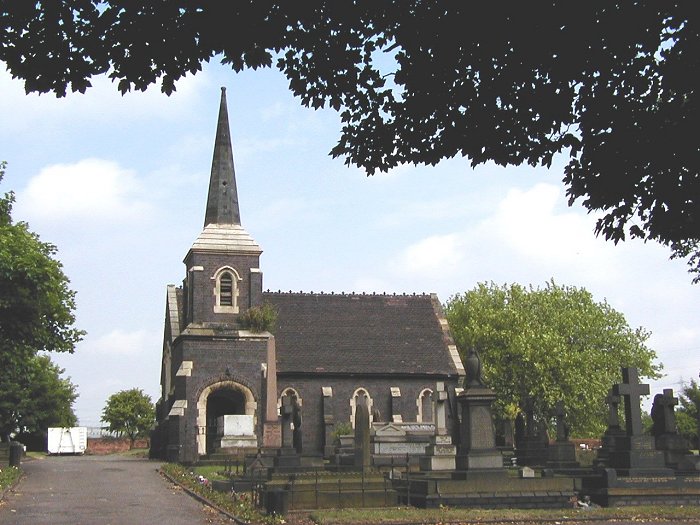
The fine Anglican mortuary chapel
that stood in James
Bridge Cemetery. |
|
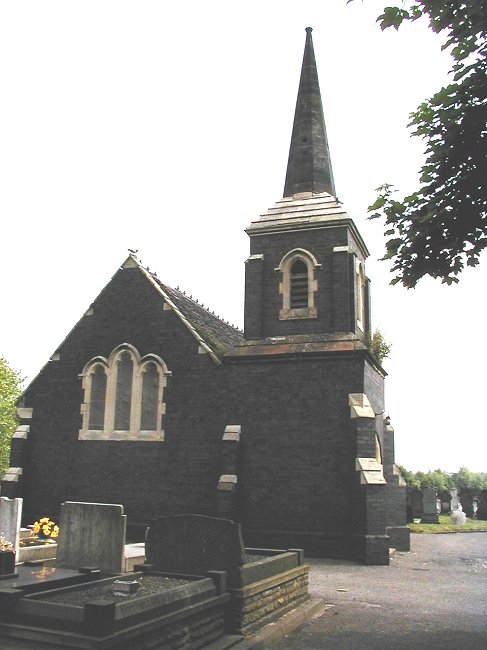
An end view of the Anglican
mortuary chapel. |
By the late 1850s Darlaston's main graveyard in Cock
Street was rapidly running out of space for burials and
something urgently had to be done. In 1853, 1855, and
1857 Acts of Parliament were passed that allowed
municipal authorities to build and run their own
cemeteries.
The newly formed Darlaston Local Board considered the
problem of overcrowding in Cock Street graveyard and
decided to build a municipal cemetery on a piece of
waste land in-between Bentley Mill Lane, the Walsall
Canal and the London & North Western Railway. |
| The cemetery cost around £4,000 and initially
covered about 4 acres. It opened in 1860. The first
burial, that of Henry Smith, took place on 22nd March. A
further four acres and a perimeter wall were added in
1887 at a cost of £2,000. Over the years the cemetery
has expanded to cover all of the available land and is
now full, no new burials being allowed. A fine Sexton's
house (Cemetery Lodge) was built, that's still there
today. It was empty for some time in the 1980s but is
now occupied and well cared for. There were two mortuary chapels following standard practice at the time, one
for Anglicans and one for Nonconformists. The Anglican
chapel survived until recent times, but the Nonconformist chapel
closed in 1945 after falling into a bad state of repair
and was demolished in 1948. |
|
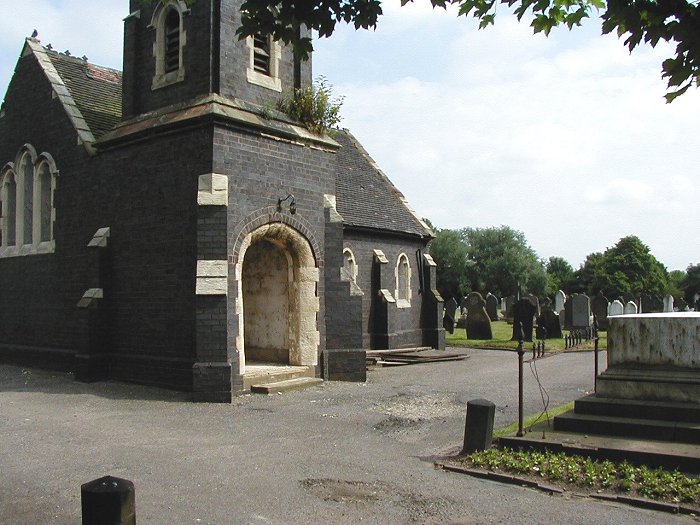
The entrance to the mortuary
chapel. |
|
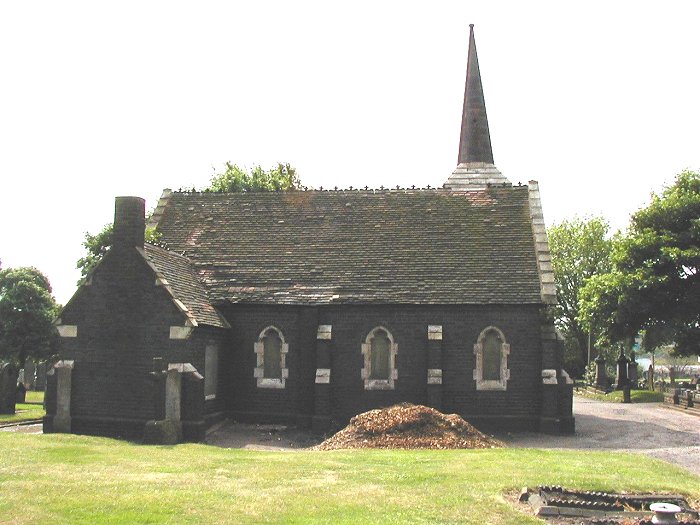
The rear of the mortuary
chapel. |
|
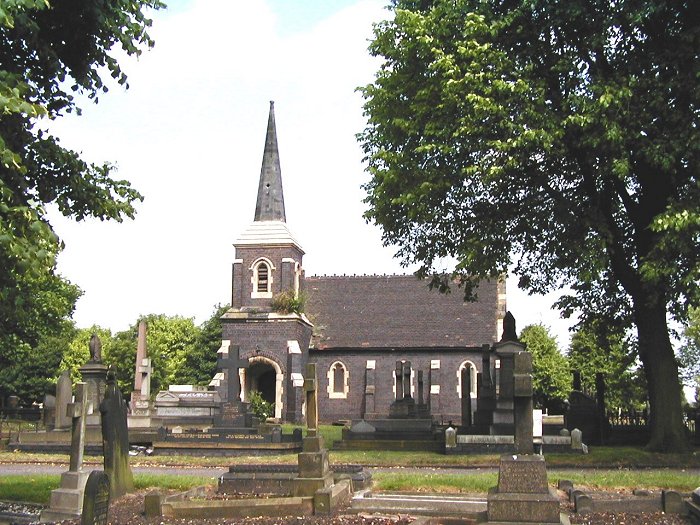
Another view of the mortuary
chapel. A fine building. |
|
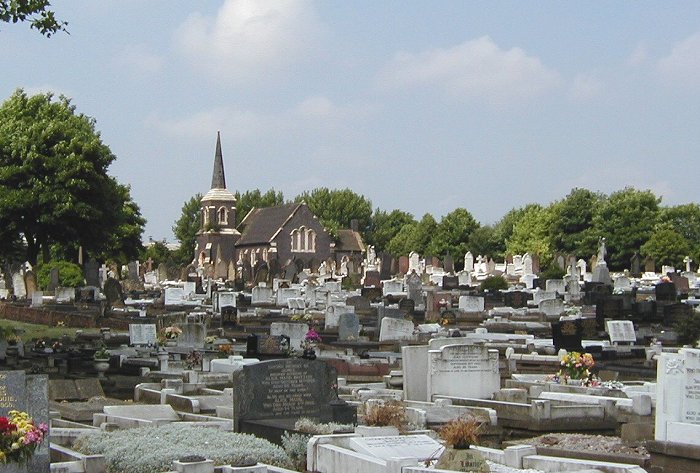
A final view of the Anglican
mortuary chapel. |
|
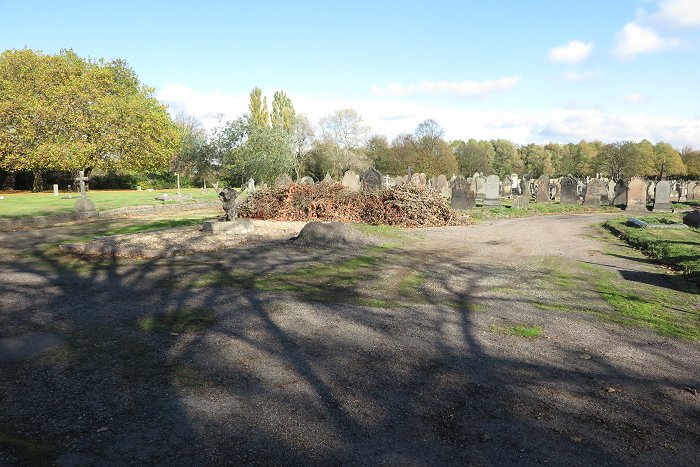
The site of the mortuary
chapel in 2018. |
| By the late 1920s the old graveyard in Cock Street
was very dilapidated and had been vandalised. The Rubery
Owen company paid for its refurbishment, and seats were
added to turn it into a garden of rest. It opened in
1932 and was
dedicated to the late Mr. A. E. Owen, but in recent
times the burial ground fell into disrepair. The
graveyard has now been refurbished and is sandwiched
in-between St. Lawrence Way and ASDA. |
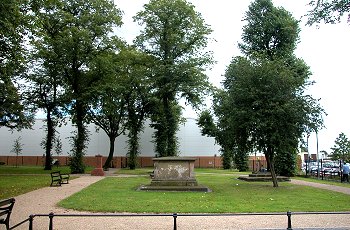
| Cock Street
Graveyard as it is today. Cock Street ran
along the right-hand side of the site. |
|
| |
|
Read the Darlaston section
from Harrison, Harrod & Company's Directory and
Gazetteer
of Staffordshire, published in 1861 |
 |
| |
|
 |
 |
 |
Return to The Grand
Junction Railway |
Return to
Contents |
Proceed to
Industries |
|